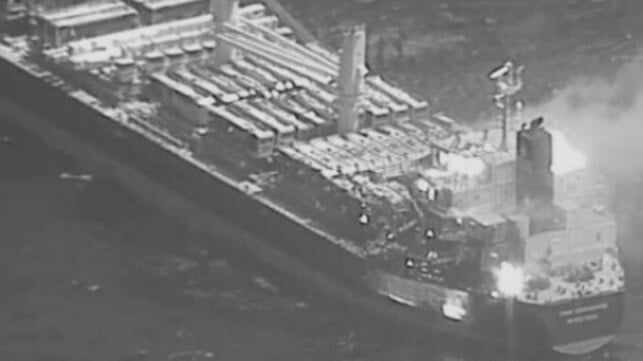Op-Ed: Trump's Strikes on Houthis Won't Work Any Better Than Biden's
The naval task force in the Red Sea and Gulf of Aden is an example of a downstream problem response.

[By Mark O'Neill]
The Houthis have proven resilient in the face of strikes. The Trump administration’s strikes this month on Yemen are not the first effort to disrupt the ongoing attacks on shipping in the Red Sea. The Biden administration launched Operation Prosperity Guardian in December 2023, a multinational effort involving 10 nations to ensure freedom of navigation, targeting the Houthis with strikes and created a multinational naval task force in the Red Sea to protect shipping.
Neither action has been a deterrent – as seen in the Houthis allegedly launching two retaliatory attacks against the US aircraft carrier Harry S. Truman within a few hours of the 16 March strike. “More of the same” will not deliver a different outcome.
Shipping traffic through the Red Sea has decreased by 65 per cent since November 2024, while traffic around the Cape of Good Hope has increased by 70 per cent. The problem in the current approach is the lack of deterrence upon, and prevention of, Houthi action. The Houthis will just keep sending raiding forces, drones and missiles to attack shipping in the area. And the naval task force will continue to try and defeat the attacks.
The naval task force in the Red Sea and Gulf of Aden is an example of a downstream problem response. And US and multinational strikes are playing “whack-a-mole”, proving ineffectual in addressing the problem. The Houthi war machine remains resilient in the face of these strikes and Houthi resolve also appears strong.
Importantly, the Houthis have already largely met their information campaign objectives at the point an attack on is launched – any resultant damage is just a bonus. This shows the limits of air strikes when fighting resolute irregular forces without suitable partner forces on the ground. It also highlights the need for change. More of same will simply maintain the status quo, with minimal reduction in threat to shipping.
Despite the Houthi’s apparent resilience, the situation within Yemen isn’t entirely favourable for them. The Houthis are part of the Shia minority (roughly a third to two-thirds Sunni) in an overwhelmingly Muslim nation. Their alignment with Iran, combined with their use of acute and structural violence in the areas they control, has made them deeply unpopular. Houthi claims that their actions are only about supporting Hamas in Gaza deserve scepticism. There is evidence the supporting “Gaza” narrative is popular domestically, but assessments that ending the conflict in Gaza will see the strikes cease are contestable in light of wider Houthi motivations.
Schisms inside Yemen, including the presence of resistance groups, offer opportunity. The development of partnerships with local actors to degrade and subvert Houthi control, could present the Houthis with challenges. This would require a change in military approach from kinetic attacks to an unconventional warfare approach.
Since 2015 the Houthis have faced a Saudi-led coalition of 10 countries. The coalition’s efforts have included airstrikes, deployment of ground troops and the training of resistance groups. The conflict has eased since the end of a UN- brokered six-month truce in October 2022, and with the resumption of Omani mediated Saudi / Houthi peace talks in April 2023. Nonetheless, ongoing “military provocations” remain, and an enduring humanitarian crisis is worsening. Both these issues – ongoing internal conflict supported by external actors, and the dire need for humanitarian relief within Yemen, are matters that clever statecraft could use as leverage upon the Houthi leadership.
Iran’s part cannot be ignored. It has been suggested that the degradation of Hezbollah and Hamas leaves the Houthis as a stand-out Iranian proxy actor for action against US and Western interests. But increasingly the Houthis are also seen less as a proxy and more of a “willing partner” as their regional influence grows.
Nonetheless, developing actions and sanctions to reduce Iranian support, and finding ways to create a wedge between Iranian and Houthi interests, will be useful. Concurrently, other putative “supporters”, including China and Russia, should be called out and, where possible, held to account.
The latest US strikes on Houthi targets will likely prove more performative than effective in reducing the instance of attacks on shipping. The latest strikes continue a flawed “downstream problem” response begun during the Biden administration. The Houthi missile threat will only be resolved by “going upstream” and adopting fresh approaches that directly challenge Houthi control and resilience on the ground.
Dr Mark O’Neill works at Synergy Group Australia and has over four decades experience in defence and national security. In 2006 Mark was the first Chief of Army Fellow at the Lowy Institute for International Policy. He holds a PhD from the University of New South Wales.
This article appears courtesy of The Lowy Interpreter and may be found in its original form here.
The opinions expressed herein are the author's and not necessarily those of The Maritime Executive.
